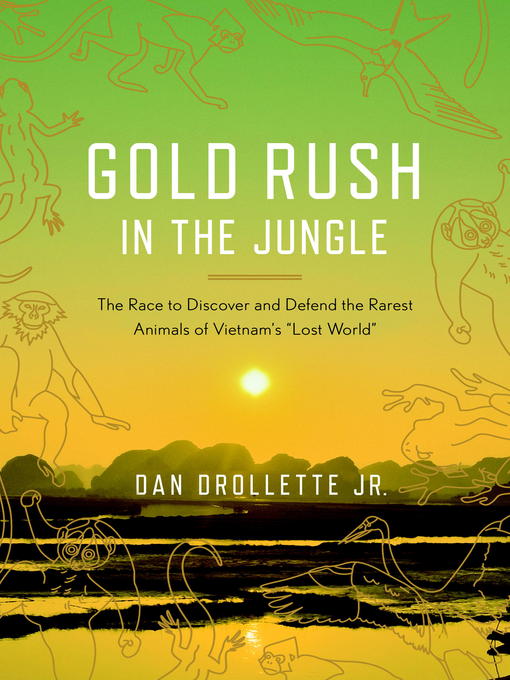
Gold Rush in the Jungle
The Race to Discover and Defend the Rarest Animals of Vietnam's
کتاب های مرتبط
- اطلاعات
- نقد و بررسی
- دیدگاه کاربران
نقد و بررسی

February 25, 2013
In 1937 at the Paris Zoo, a “fabled wild forest ox” emerged from the tumult of an Indochinese shipment of common wildlife. The accidental passenger turned out to be the only Kouprey ever recorded in captivity, and it later disappeared amidst the madness of German-occupied France. A near-mythic creature figured in bas relief at Angkor Wat, the Kouprey has been hotly pursued ever since. If recaptured and bred with modern cattle, the result would be a “supercow” immune to multiple diseases. Its ancient genes could be worth billions. The Kouprey is just one of many fetching creatures that haunt this book and the Southeast Asian region known as the “Lost World.” Because of the remoteness of the land and the conflicts that have plagued the area over past decades, its exotic inhabitants—like a barking deer or a pig-nosed 200-lb soft-shell turtle—have largely been overlooked. Modern poachers, however, have made up for lost time, smuggling out tragic caravans of trophy creatures for slaughter. But some brave scientists are dedicated to protecting them, and veteran science journalist Drollette ably details both the poetic and practical reasons to defend such lost worlds and their bizarre residents. Agent: Matthew Carnicelli, Carnicelli Literary Management.

March 15, 2013
A science journalist's on-the-ground observations about the threatened wildlife of Vietnam and efforts to discover hitherto-unknown species and to protect rapidly disappearing ones. In his debut, Drollette chronicles his experiences in Vietnam, describing not a mineral gold rush, but a biological one. He interviewed wildlife biologists currently working there, quotes earlier researchers and delves into the history and present conditions of the once-war-torn country. His primary focus is the Endangered Primate Rescue Center, run by Tilo Nadler, a German zoologist, and his Vietnamese wife. A prologue sets the scene, describing the rare mammals recently found in Vietnam and raising questions for which Drollette seeks answers: How did they survive there? What will happen to them under such present stresses as economic progress, population growth, deforestation and poaching? The author first visited Vietnam in 1998, an experience that he briefly covers in the first part, but his return more than a decade later provides the book's core. He finds that Vietnam's unique and once-hidden animal life is now vulnerable to exploitation, and their numbers are dwindling; there are, however, signs of progress that give hope: Nadler's work on protecting langurs, for example, has expanded greatly since Drollette's previous visit. Besides trying to uncover the effects of Agent Orange and other chemicals dumped on Vietnam during the war, the author exposes the massive illegal marketing of wild animal parts much in demand for use in Asian medicines. Drollette also reports on efforts to protect turtles in a lake in Hanoi and of the work of Hawaii's National Tropical Garden in preserving rare plants. These accounts are certainly informative, but they seem misplaced here. The book's principle flaw is that at times it reads more like a patchwork of previously published feature articles than a single cohesive work. Generally well-researched and -written, but somewhat unfocused and repetitive.
COPYRIGHT(2013) Kirkus Reviews, ALL RIGHTS RESERVED.

March 15, 2013
The jungles of Vietnam hold a treasury of rare and endangered species that have attracted the attention of scientists, smugglers, and poachers. Science writer Drollette traveled into the jungle for interviews and firsthand experience of the characters, human and animal, in the drama of preservation versus economic development. He details the labors of researchers and scientists, including a promising generation of young Vietnamese biologists and park rangers, to protect many rare and endangered species. The jungle is also the home of new species of plants and animals, including the half-goat/half-ox, the missing link between domestic cattle and their ancient wild forebears, and a close relative of the nearly extinct Javan rhino. Drollette explores why so many animal species have managed to survive in Vietnam through centuries of change, including what they call the American War, and the current challenges from ambitious zoologists looking to make their careers with discoveries of exotic new wildlife. Given its promise of biological treasure, Vietnam is at the forefront of efforts to balance preservation and economic development.(Reprinted with permission of Booklist, copyright 2013, American Library Association.)

























دیدگاه کاربران